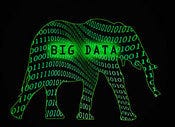Big Data Ushers In 'Virtuous Cycle Of Computing'Big Data Ushers In 'Virtuous Cycle Of Computing'
IT is entering a new era where devices attract users, who in turn attract more devices. It's a 'virtuous' whirlwind of data-driven progress, says Intel exec.

5 Big Wishes For Big Data Deployments(click image for larger view and for slideshow)
The proliferation of consumer devices and machine-to-machine sensors is ushering in a new era for IT: a cloud-computing age that enables services to be deployed more rapidly thereby attracting an ever-increasing number of users and devices.
Intel has coined a name for this epoch, the "Virtuous Cycle of Computing," referring to a system of events that reinforces itself in a continuous loop. The driver of this cycle: big data.
In her Monday keynote at Intel's "Reimagine the Datacenter" event in San Francisco, Diane Bryant, senior VP and general manager of Intel's Datacenter and Connected Systems Group, said the dramatic upsurge in end-user and machine-to-machine devices -- two areas commonly associated with big data -- is good news for the IT industry.
"We're going through a significant transformation in the way that IT is fundamentally used," said Bryant. Two factors are making this happen, she added: Cloud computing and the "massive build-out" of devices. "We're going into a whole new era where we look at IT as a service," she said. "IT is no longer supporting the business, but IT is actually the business."
[ In one possible future, everything will have a sensor. Read The Internet Of Things Gold Rush. ]
IT continues to evolve to meet changing business needs. The 1990s marked the "computer-centric era," one where manual systems were automated to increase efficiency. The 2000s brought pervasive Internet connections and the growth of wireless, developments that expanded IT's role in a burgeoning "network-centric" era.
"You could change the way businesses communicate with businesses -- do things like B2B supply chain management systems -- or change the way businesses communicate with their customers through online marketing," said Bryant. IT's current metamorphosis is being driven in part by the rise of the machines -- the Internet of Things -- a development that includes B2B hardware sharing massive volumes of data.
"When you go machine-to-machine and the Internet of Things, the load becomes even greater," Bryant said. "For every 20 digital signs, you'll need a server in the background to deliver that content. And for just 12 surveillance cameras, you'll need a server in the data center to deliver that content."
Bryant estimated that more than 14 billion devices will come online by 2016. Five billion of them will be consumer machines such as tablets and smartphones; the other 9 billion will be machine-to-machine hardware.
"As those devices come online, they require a connection back to the data center," she said. "For every 600 phones, you're going to need another server in a data center. For every 120 tablets, you'll need a server."
Disney and Bocom, the latter a Shanghai-based supplier of intelligent sensing and networking technologies in China, are two companies putting these new IT services into action, Bryant said.
Walt Disney World in Florida, for instance, is currently testing MagicBands, flexible wristbands designed to help the resort's guests enter the parks, access rides and, of course, buy stuff more easily.
"When you enter Disney World, you'll get a MagicBand,"said Bryant. The wearable device contains your credit card information, making it a handy way to pay for goods and services.
MagicBand offers other services as well. "They'll have digital signs. When you walk by, it can greet you. It can wish you a happy birthday," Bryant added. "It can direct you to your favorite ride when the line for that ride is at its lowest. And then the park itself can use this information to manage park flow -- to drive up the ride utilization and drive down wait times." Bocom, in conjunction with the Chinese government, is using Intel technology to implement a smart transportation system in the nation's Tier 1 provinces.
"We deployed 20,000 surveillance cameras and 30,000 sensors around all the streets," said Bryant. "This has enabled them to identify traffic in real time and … lower the congestion and drive up safety."
About the Author
You May Also Like







